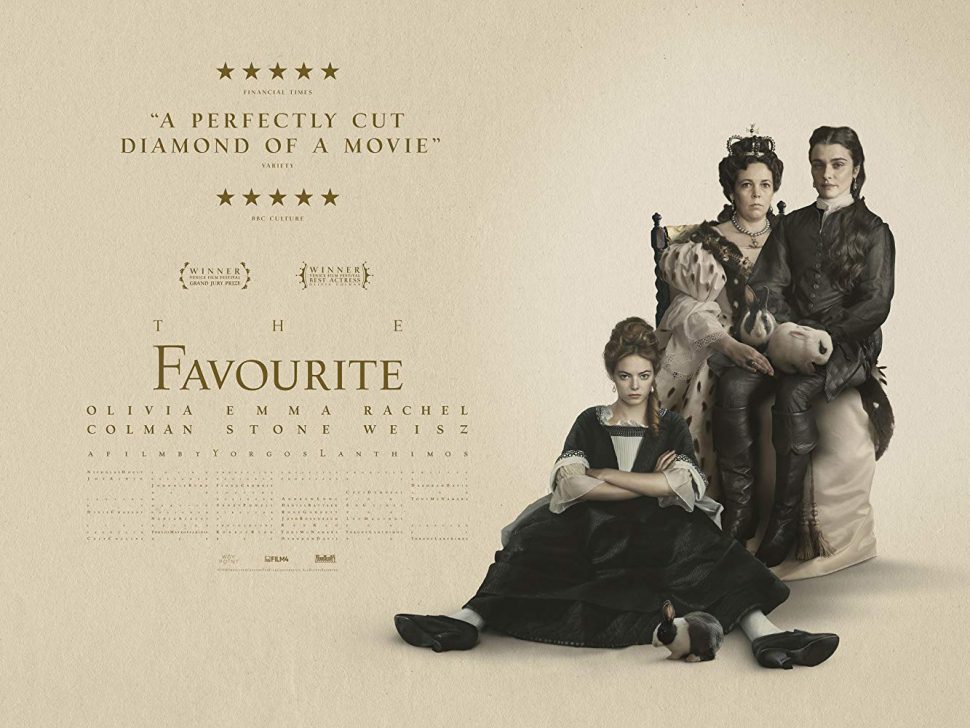 We hear the faintest sound of rabbits frolicking during the opening seconds of “The Favourite,” even before we see anything. It’s so faint, we may not even recognise what the sounds are at first. It’s the first of many tricks that the film will play on us, but the injection of the rabbits’ purrs immediately unbalances. It is as if the film is already in motion before we get to it. We hear the rabbits purring, the urgent sound of quick footsteps, a door opening and then finally we meet the characters – the first of them is Queen Anne, with her trusted confidante and adviser Sarah Churchill. Queen Anne requests that Sarah say hello to the “children” and Sarah recoils immediately. “It is macabre,” she says. “I cannot.” And we see our caged rabbits for the first time, seventeen of them we will soon learn. But, Sarah’s reticence perplexes us. They are only rabbits. What could possibly be so macabre about them? And despite the Queen’s entreaties, and her confessed love for the queen, Sarah refuses. “Love has limits,” she proffers. Queen Anne is unconvinced of that. “It should not.”
We hear the faintest sound of rabbits frolicking during the opening seconds of “The Favourite,” even before we see anything. It’s so faint, we may not even recognise what the sounds are at first. It’s the first of many tricks that the film will play on us, but the injection of the rabbits’ purrs immediately unbalances. It is as if the film is already in motion before we get to it. We hear the rabbits purring, the urgent sound of quick footsteps, a door opening and then finally we meet the characters – the first of them is Queen Anne, with her trusted confidante and adviser Sarah Churchill. Queen Anne requests that Sarah say hello to the “children” and Sarah recoils immediately. “It is macabre,” she says. “I cannot.” And we see our caged rabbits for the first time, seventeen of them we will soon learn. But, Sarah’s reticence perplexes us. They are only rabbits. What could possibly be so macabre about them? And despite the Queen’s entreaties, and her confessed love for the queen, Sarah refuses. “Love has limits,” she proffers. Queen Anne is unconvinced of that. “It should not.”
And with that line we cut, finally, to the title of our film, “The Favourite.”
For the next two hours, “The Favourite” will take us on a perverse journey of deception, subterfuge, desire and hilarity. If Anne’s words—that love should not have a limit—present a hypothesis then the film that follows becomes to experiment as to whether that hypothesis is true. Its opening establishes the two critical elements that will sustain it throughout: the limits of love, and the shadows of the rabbit.
The time is the very early 18th century. Queen Anne sits on the throne of England, in frail health but not necessarily in frail spirit. Her business is attended to by Lady Sarah, the woman behind the Queen ruling the country through her sheer influence and gumption. But their relationship, a furtive and dizzying romance, is threatened when Sarah’s cousin arrives at Court and catches the Queen’s eye. The not-quite-romantic triangle at the centre of the film is integral to its development. It is especially essential that the mercurial Queen Anne, the stoic and deliberate Sarah and the charming Abigail exist as women with their own stories even as the film’s main story throws them into contact with each other, playing a game where the rules are uncertain. “The Favourite” is not quite a love story in the traditional sense and yet the ways that love congeals, affects and poisons are essential to the progression of the plot, although the word “love” seems at once too much, and too little, for the emotions these characters experience.
“The Favourite” is a story of the different ways a woman must work to navigate a life at court in 1700s. Abigail, born a lady, is thrust into a life of servitude because of her father. The Queen, born into royalty, must make decisions to rule a country where her interest in that ruling seems incidental at best. Lady Sarah must use her influence to makes the plans of a politician, even though as a woman she has no actual voice in the political halls of court. But these women must adapt and do what they can to navigate the world they inhabit. And good navigation depends on unerring adaptability and adaptability depends on one’s need to be constantly changing. For while in private the three women vie for power, in the public sphere England is at war with France, Lady Sarah’s husband is on the frontline, the Tory Prime Minister is uncertain about the money being spent on the war and Queen Anne seems to be losing control of her court. Chaos within and chaos without. But, it all comes back to the women. The sexual and feminine politics of the trio are such that our allegiances are constantly shifting and even as each character leans into a nastiness that is delicious to watch the film surprises us by making us feel for each of them even when they are at their worst.
“The Favourite” becomes a dizzying, frustrating, compelling, unnerving riff on Joan Riviere’s idea of womanliness as masquerade. Riviere’s idea that fraudulent femininity as a concealment of a woman’s desire for masculine attributes is disputed here where the range of feminine behaviour the film proffers all exist not in relation to masculinity but in clear dismissal of it. And, concealment whether covert or overt, defines the interactions of the women at the centre of the film. Feelings, bodies, and words are all equal playground for varying elements of disguises. And with disguises come the dissemblance and “The Favourite” uses both to excellent effect.
Dissemblance is both a stylistic choice and a thematic essentiality. So, this story that depends on the baroque qualities of Queen Anne’s court retains a constant air of modernity from its anachronistic dialogue, to its forward thinking costume design and its decidedly period inappropriate dance moves that accentuate a key scene. The obsession with dissembling illusions goes beyond that, though. The film’s most notable stylistic mark is the use of obscenely wide-angle lenses to warp the space of the things we see on screen that turns into almost a burlesque version of the “fish-eye” lens.
Cinematographer Robbie Ryan takes the lush costumes and sets and emphasises the grotesquery within them, or sometimes creates the grotesque from where there was none, so that we come to doubt our very eyes. It’s immediately effected in the way the film plays with light and darkness in one of my favourite recurring moments in the film – a shot of Rachel Weisz as Lady Sarah, walking through a dark hallway in moments of varying moods. The most compelling is a particularly staggering walk as she recedes from sight after a shocking discovery. As she walks, accompanied by only a lit candle, the darkness encroaches around her daring us to discern – what can you even see? Not much. And we can’t really trust what we see anyhow, when everyone is in disguise.
But, it’s not all morbid fun and devilish games. We will learn that the collection of rabbits is not merely ornamental. The seventeen rabbits, so macabre to Sarah, are tokens of the seventeen babies Anne has lost to miscarriage or infant death. “Each one that dies, a little bit of you goes with them,” she confesses in a rare moment of unhidden sincerity in the film. It is not that the film’s avoidance of naked truth is to its detriment. There can be no naked truth when characters are not even being honest with themselves. Greek director Yorgos Lanthimos has made a career of siphoning the most perverse elements of humanity for his artistic experiments. “The Favourite” is his most accessible film even as it basks in an unusualness and perversity that one might not expect from a period film about a Queen of England. The ostensible accessibility itself, though, is a disguise because the film beguiles you with its familiarity, only to upend you with moments that unmoor you later on.
‘Sometimes a woman likes to have her fun,’ Lady Sarah purrs midway through the film. And “The Favourite” is a lot of fun. The film is constantly mocking the validity of the identities we disguise ourselves in. But, how quickly fun gives way to excess and then to the grotesque and then to the painful. And the higher the stakes get, the more the fun becomes laced with something like regret and then pain and then tragedy. Fun, like love, has its limits. For even the most fortunate lady is not lucky enough to have a life of unencumbered fun. After all, to be a woman is to forever be at the mercy of one’s station in life. It’s good to be Queen, but even the Queen must face the limitations of her existence as a human and when the love she experiences shows its limits, there is little to do to stop it. Fun can only take one so far.





